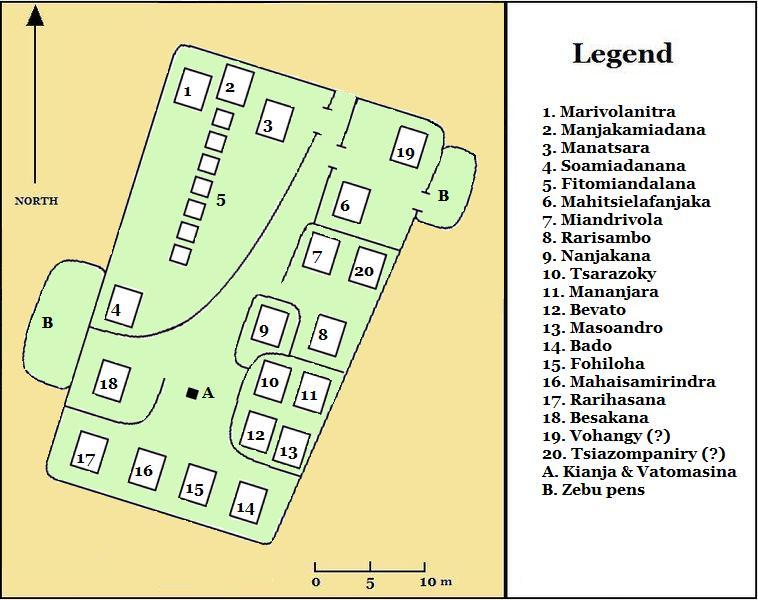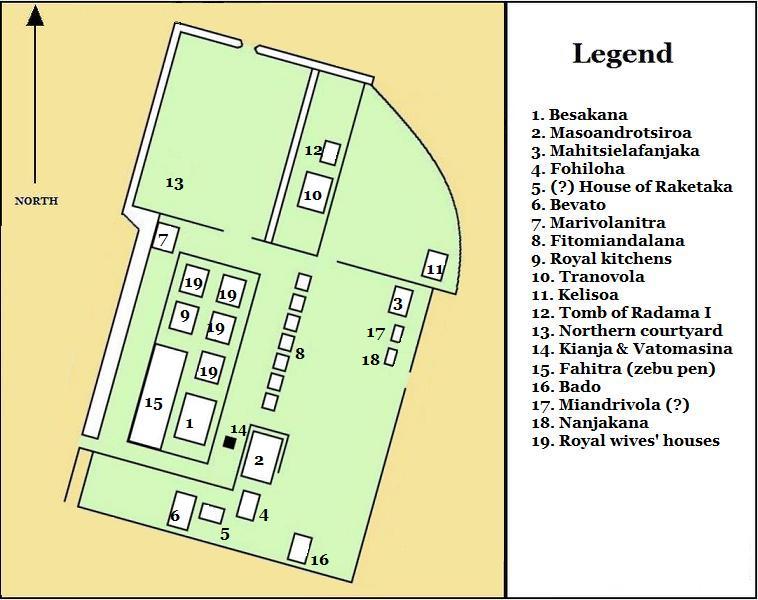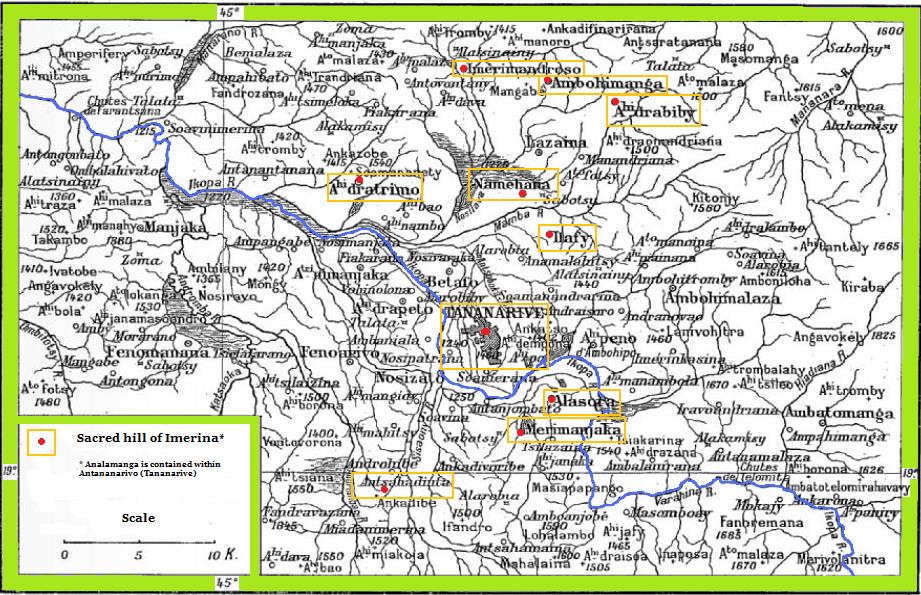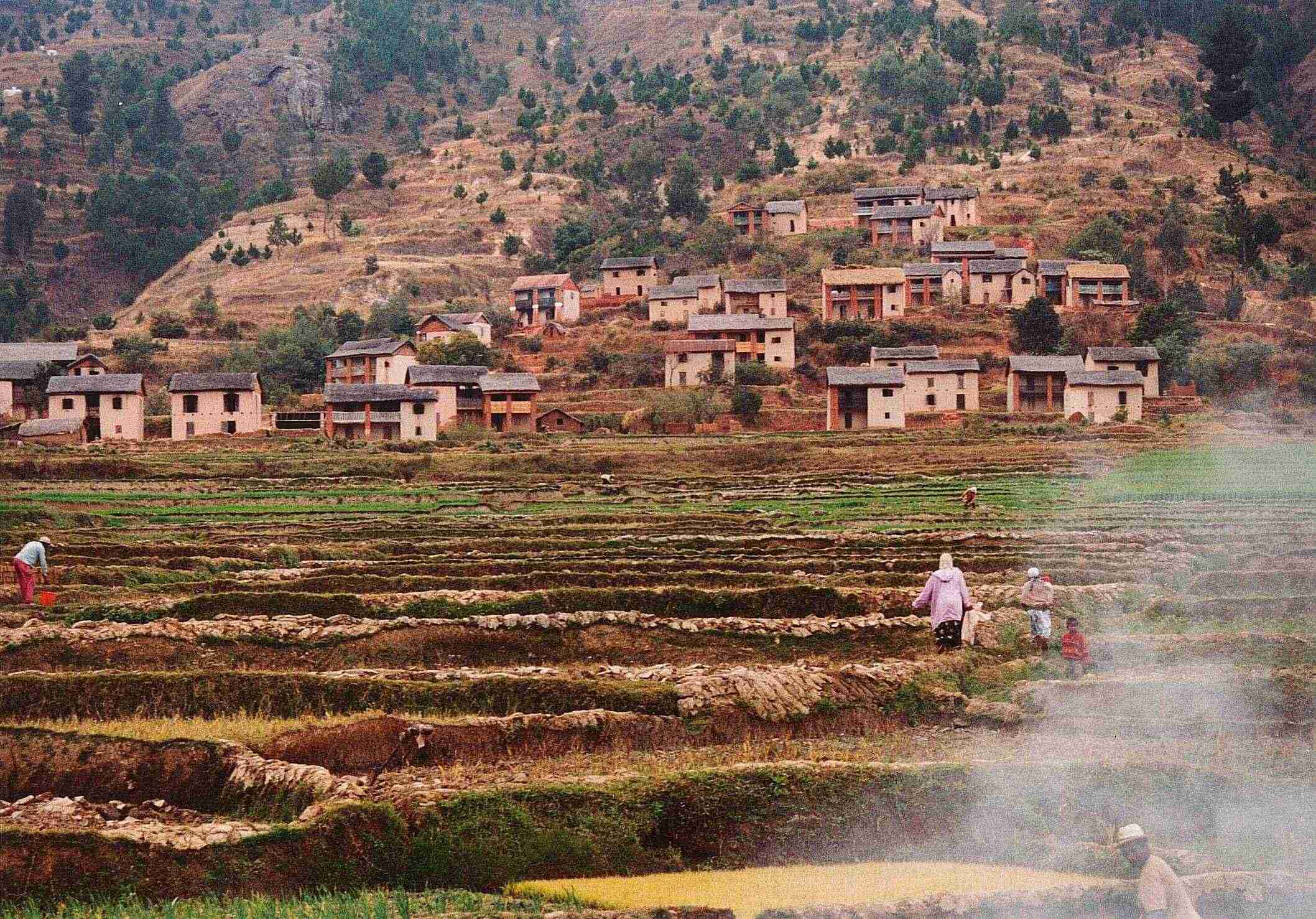|
Andrianjaka
Andrianjaka reigned over the Kingdom of Imerina in the central highlands region of Madagascar from around 1612 to 1630. Despite being the younger of King Ralambo's two sons, Andrianjaka succeeded to the throne on the basis of his strength of character and skill as a military tactician. The most celebrated accomplishment of his reign was the capture of the hill of Analamanga from a Vazimba king. There he established the fortified compound (''rova'') that would form the heart of his new capital city of Antananarivo. Upon his orders, the first structures within this fortified compound (known as the Rova of Antananarivo) were constructed: several traditional royal houses were built, and plans for a series of royal tombs were designed. These buildings took on an enduring political and spiritual significance, ensuring their preservation until being destroyed by fire in 1995. Andrianjaka obtained a sizable cache of firearms and gunpowder, materials that helped to establish and preserve ... [...More Info...] [...Related Items...] OR: [Wikipedia] [Google] [Baidu] |
Besakana Traditional Merina Andriana House Rova Antananarivo Madagascar
The Rova of Antananarivo ( mg, Rovan'i Manjakamiadana ) is a royal palace complex (''rova'') in Madagascar that served as the home of the sovereigns of the Kingdom of Imerina in the 17th and 18th centuries, as well as of the rulers of the Kingdom of Madagascar in the 19th century. Its counterpart is the nearby fortified village of Ambohimanga, which served as the spiritual seat of the kingdom in contrast to the political significance of the Rova in the capital. Located in the central highland city of Antananarivo, the Rova occupies the highest point on Analamanga, formerly the highest of Antananarivo's many hills. Merina king Andrianjaka, who ruled Imerina from around 1610 until 1630, is believed to have captured Analamanga from a Vazimba king around 1610 or 1625 and erected the site's first fortified royal structure. Successive Merina kings continued to rule from the site until the fall of the monarchy in 1896, frequently restoring, modifying or adding royal structures within t ... [...More Info...] [...Related Items...] OR: [Wikipedia] [Google] [Baidu] |
Rova Of Antananarivo
The Rova of Antananarivo ( mg, Rovan'i Manjakamiadana ) is a royal palace complex ('' rova'') in Madagascar that served as the home of the sovereigns of the Kingdom of Imerina in the 17th and 18th centuries, as well as of the rulers of the Kingdom of Madagascar in the 19th century. Its counterpart is the nearby fortified village of Ambohimanga, which served as the spiritual seat of the kingdom in contrast to the political significance of the Rova in the capital. Located in the central highland city of Antananarivo, the Rova occupies the highest point on Analamanga, formerly the highest of Antananarivo's many hills. Merina king Andrianjaka, who ruled Imerina from around 1610 until 1630, is believed to have captured Analamanga from a Vazimba king around 1610 or 1625 and erected the site's first fortified royal structure. Successive Merina kings continued to rule from the site until the fall of the monarchy in 1896, frequently restoring, modifying or adding royal structures withi ... [...More Info...] [...Related Items...] OR: [Wikipedia] [Google] [Baidu] |
Imerina
The Merina Kingdom, or Kingdom of Madagascar, officially the Kingdom of Imerina (–1897), was a pre-colonial state off the coast of Southeast Africa that, by the 19th century, dominated most of what is now Madagascar. It spread outward from Imerina, the Central Highlands region primarily inhabited by the Merina ethnic group with a spiritual capital at Ambohimanga and a political capital west at Antananarivo, currently the seat of government for the modern state of Madagascar. The Merina kings and queens who ruled over greater Madagascar in the 19th century were the descendants of a long line of hereditary Merina royalty originating with Andriamanelo, who is traditionally credited with founding Imerina in 1540. In 1883, France invaded the Merina Kingdom to establish a protectorate. France invaded again in 1894 and conquered the kingdom, making it a French colony, in what became known as the Franco-Hova Wars. History Hova-Vazimba conflict Madagascar's central highla ... [...More Info...] [...Related Items...] OR: [Wikipedia] [Google] [Baidu] |
Andriamasinavalona
Andriamasinavalona (1675–1710), also known as Andrianjakanavalondambo, was a King of Imerina in the central highlands of Madagascar. He made significant and enduring contributions to the social, political and economic life of Imerina. Chief among these was the expansion of his territories and the pacification and unification of certain principalities that had become locked in violent conflict; Andriamasinavalona established and ruled over the largest extent of the Kingdom of Imerina. He gave the name of Antananarivo to the capital city that was rapidly expanding around the royal palace on the hill of Analamanga, created a large public square at Andohalo outside the gates of the city, and named a series of other locations within the city. He also took possession of a distant hill he renamed Ambohimanga as a lodging for his son Andriantsimitoviaminiandriana; the royal city that developed there has been declared a UNESCO World Heritage Site. The innovations of Andriamasinavalo ... [...More Info...] [...Related Items...] OR: [Wikipedia] [Google] [Baidu] |
Antananarivo Rova-Palast
Antananarivo (French: ''Tananarive'', ), also known by its colonial shorthand form Tana, is the capital and largest city of Madagascar. The administrative area of the city, known as Antananarivo-Renivohitra ("Antananarivo-Mother Hill" or "Antananarivo-Capital"), is the capital of Analamanga region. The city sits at above sea level in the center of the island, the highest national capital by elevation among the island countries. It has been the country's largest population center since at least the 18th century. The presidency, National Assembly, Senate and Supreme Court are located there, as are 21 diplomatic missions and the headquarters of many national and international businesses and NGOs. It has more universities, nightclubs, art venues, and medical services than any city on the island. Several national and local sports teams, including the championship-winning national rugby team, the Makis are based here. Antananarivo was historically the capital of the Meri ... [...More Info...] [...Related Items...] OR: [Wikipedia] [Google] [Baidu] |
Antananarivo
Antananarivo ( French: ''Tananarive'', ), also known by its colonial shorthand form Tana, is the capital and largest city of Madagascar. The administrative area of the city, known as Antananarivo-Renivohitra ("Antananarivo-Mother Hill" or "Antananarivo-Capital"), is the capital of Analamanga region. The city sits at above sea level in the center of the island, the highest national capital by elevation among the island countries. It has been the country's largest population center since at least the 18th century. The presidency, National Assembly, Senate and Supreme Court are located there, as are 21 diplomatic missions and the headquarters of many national and international businesses and NGOs. It has more universities, nightclubs, art venues, and medical services than any city on the island. Several national and local sports teams, including the championship-winning national rugby team, the Makis are based here. Antananarivo was historically the capital of the Merina peop ... [...More Info...] [...Related Items...] OR: [Wikipedia] [Google] [Baidu] |
Ralambo
Ralambo was the ruler of the Kingdom of Imerina in the central Highlands region of Madagascar from 1575 to 1612. Ruling from Ambohidrabiby, Ralambo expanded the realm of his father, Andriamanelo, and was the first to assign the name of Imerina to the region. Oral history has preserved numerous legends about this king, including several dramatic military victories, contributing to his heroic and near-mythical status among the kings of ancient Imerina. The circumstances surrounding his birth, which occurred on the highly auspicious date of the first of the year, are said to be supernatural in nature and further add to the mystique of this sovereign. Oral history attributes numerous significant and lasting political and cultural innovations to King Ralambo. He is credited with popularizing the consumption of beef in the Kingdom of Imerina and celebrating this discovery with the establishment of the ''fandroana'' New Year's festival which traditionally took place on the day of Ral ... [...More Info...] [...Related Items...] OR: [Wikipedia] [Google] [Baidu] |
Twelve Sacred Hills Of Imerina
The twelve sacred hills of Imerina are hills of historical significance to the Merina people of Madagascar. Located throughout Imerina, the central area of the highlands of Madagascar, the sites were often ancient capitals, the birthplaces of key public figures, or the tomb sites of esteemed political or spiritual leaders. The first set of sacred sites was designated by early 17th-century king Andrianjaka. The notion was re-sanctified under late 18th-century king Andrianampoinimerina, who replaced several of the earlier sites with new ones. More than 12 sites were thus designated as sacred over time, although the notion of twelve sacred hills was perpetuated because of the significance of the number 12 in Malagasy cosmology. Today, little concrete evidence of the former importance of many of these sites remains, but the significant archeological and cultural heritage of several of the sites has been preserved. The historic significance of the sites is best represented by the ... [...More Info...] [...Related Items...] OR: [Wikipedia] [Google] [Baidu] |
List Of Imerina Monarchs
This article lists the Imerina monarchs, from the earliest origins of the Merina monarchy until the French conquest of the Merina Kingdom during the Second Madagascar expedition. Early monarchs in the Merina line Below is a list of the line of Merina monarchs that ruled in the Central Highlands of Madagascar and from whom were issued the first true monarchs of a united Madagascar in the 19th century. Before the uniting of Madagascar, succession was based on the current monarch's designation of an heir, typically from among his or her own children. As such, the list below represents a direct genealogical line from the last 19th-century queen of Madagascar to some of the earliest known rulers identified in the 15th century or before. Prior to the 16th century, detailed information about the names and dates of Merina rulers becomes less consistent. Genealogy in this early period are derived primarily from oral history, while later names and dates are verifiable from primary sources ... [...More Info...] [...Related Items...] OR: [Wikipedia] [Google] [Baidu] |
Andriantsitakatrandriana
Andriantsitakatrandriana (1613-) was the king of Imerina from 1630 to 1650, acceding to the throne upon the death of his father, Andrianjaka. He took two wives: the first, Ravololontsimitovy, gave birth to his first son and successor Andriantsimitoviaminandriandehibe, while his second wife, Rafoloarivo, gave birth to a son named Andriamanjakatokana. During his reign, he chased his second wife and son from his territory, and constructed dikes to transform the Betsimitatatra swamps around Antananarivo into vast rice paddies to feed the local population. Reign The chief accomplishment of Andriantsitakatrandriana's reign was the initial transformation of the vast Betsimitatatra swamps surrounding the hill of Analamanga into fertile rice paddies through the construction of dikes. Until his time, only ''zozoro'' (an indigenous sedge), rushes, and clusters of trees grew in the marshy lands around the capital city of Antananarivo, which his father had at last wrested from its Vazimba occupa ... [...More Info...] [...Related Items...] OR: [Wikipedia] [Google] [Baidu] |







